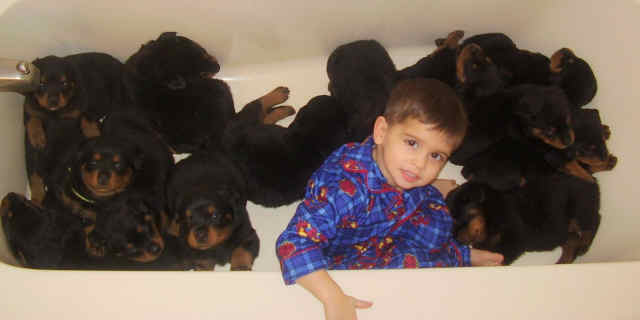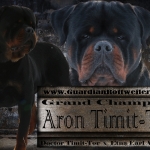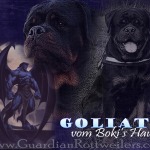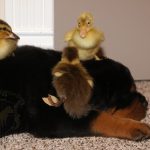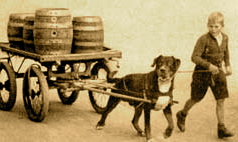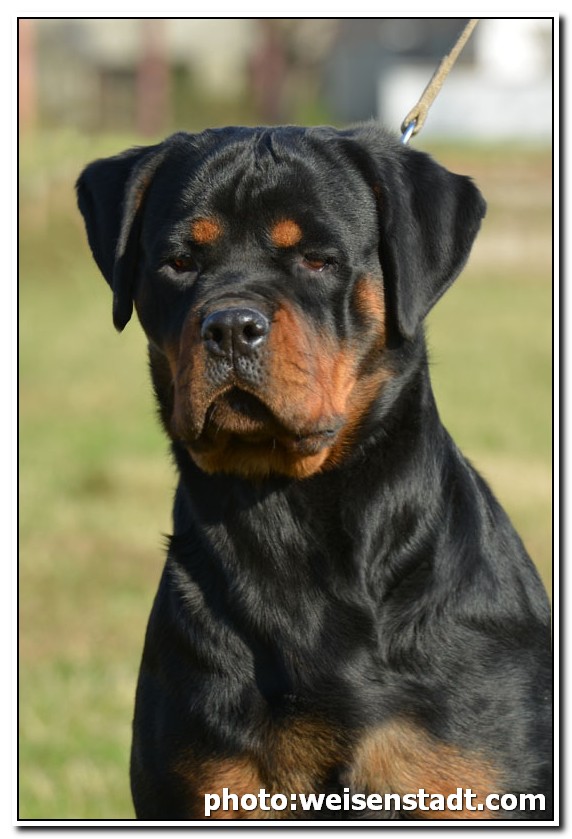Canine Hip Dysplasia
I composed this page specifically for Rottweilers with many Rottie specific references, however, the information regarding canine hip dysplasia and other joint issues are applicable to all large and giant breed dogs and some medium size breed dogs. The purpose of this web page is to dispense useful information on some fairly common issues among large breed dogs, however, it is not intended to take the place of veterinary advice. If you ever suspect your dog to be experiencing any distress or movement issues, a veterinarian is the only one capable of diagnosing.
GENETIC MANIPULATION– The creation of dog breeds
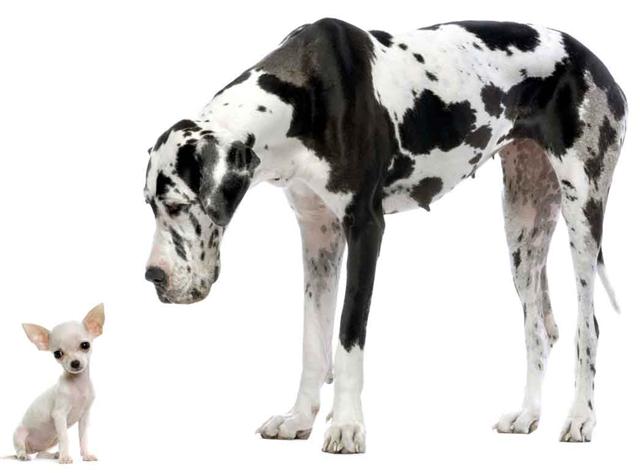 When we began to manipulate canine genetics in the endeavor of forming the perfect breeds of dogs to suit our needs, we inadvertently imposed inherent genetic diseases in the breeds we created. Some of the breeds’ disorders and genetic issues are a result of a limited gene pool and some of the genetic diseases are a direct result of the physical extremes we have imposed on the dogs- i.e. “Wet” breeds (lots of loose skin) like the Shar Pei, St. Bernard, Mastiff, Bloodhounds, etc. are prone to entropian and ectropian as well as skin problems; floppy eared dogs are prone to ear infections; brachiocephalic breeds (smooshed face) like the Pug, Shih Tzu, Bulldog, etc. are prone to respiratory issues and sensitive to temperature changes, and of course large breed dogs with extreme growth rates are subject to culpability for that crazy growth and the toll it takes on large muscle groups like the heart and on the bones and joints like the hips and elbows.
When we began to manipulate canine genetics in the endeavor of forming the perfect breeds of dogs to suit our needs, we inadvertently imposed inherent genetic diseases in the breeds we created. Some of the breeds’ disorders and genetic issues are a result of a limited gene pool and some of the genetic diseases are a direct result of the physical extremes we have imposed on the dogs- i.e. “Wet” breeds (lots of loose skin) like the Shar Pei, St. Bernard, Mastiff, Bloodhounds, etc. are prone to entropian and ectropian as well as skin problems; floppy eared dogs are prone to ear infections; brachiocephalic breeds (smooshed face) like the Pug, Shih Tzu, Bulldog, etc. are prone to respiratory issues and sensitive to temperature changes, and of course large breed dogs with extreme growth rates are subject to culpability for that crazy growth and the toll it takes on large muscle groups like the heart and on the bones and joints like the hips and elbows.
With the genetic disorders that are caused either indirectly from the creation of the breed (smaller genetic pools cause exaggerated tendencies for issues) or directly as a result of the creation of the breed (the physical changes we bred into the breed are the cause of the genetic issues) there are usually ways to try to improve the odds for the individual dogs. In the cases where the issues are the result of the physical changes we have created, as breeders, we use necessary medical screenings for the related issues and breed only the strongest representatives. In the specific case of large and giant breed dogs and their predisposition towards cardiac and joint issues because of the insane growth rate imposed on them by the size we have engineered them to be and the amount of output taxed on their body because of the extremes in size, there is little we can do about the growth rate on a genetic level. Canines will take a specific time to grow (12-24 months) no matter what their size, so of course, the larger breeds have a lot more ground to cover in that small space of time. However, as breeders, we can try to make the dogs’ bodies as strong as possible in defense of these growth related disorders by testing breeding dogs for heart murmurs and hip and elbow disorders. By breeding only the strongest representatives of the breed and by choosing not only dogs that have good hips, elbows and hearts, but dogs that are coming from bloodlines that also have good hips, elbows and hearts, then we can significantly improve the genetic component that contributes to these disorders.
ENVIRONMENTAL CONTRIBUTORS of CHD
This is by far one of the most comprehensive and still very easy to read articles on hip dysplasia that I have yet to encounter. It is an absolute must to read if you own a large breed dog and even more vital if you are or plan to be a breeder. Hip dysplasia starts with the breeder! A pup as young as 3 days of age can start to have detrimental consequences to his/her joints if not on the proper surface.
The 10 most important things to know about canine hip dysplasia – The Institute of Canine Biology
Although there is a genetic influence on hip dysplasia, the heritability of the trait is rather low. Many studies have shown that genetic variation accounts for only a modest fraction of the variation in hip scores, usually 15-40%. This means that some fraction of the variation in the quality of the hips is the result of non-genetic, or “environmental” influences. This is one reason why decades of strong selection has resulted in only modest reductions in hip dysplasia in some breeds. At the current rate of progress and selecting only by phenotype, it could take decades to achieve a meaningful reduction in the incidence of hip dysplasia (Lewis et al 2013).
Lewis, TW, SC Blott, & JA Woolliams. 2013. Comparative analyses of genetic trends and prospects for selection against hip and elbow dysplasia in 15 UK dog breeds. BMC Genetics 14:16.
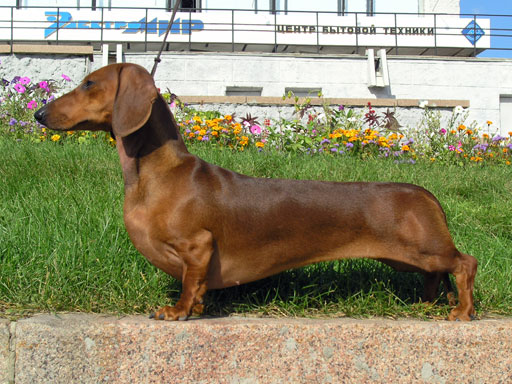 Although most of the inherent genetic disorders associated with specific breeds or size groups of dogs have a predominant genetic component, many also have a significant environmental component. I.e. small dog breeds have difficulty maintaining body temperature, however, allowing them to get chilled is what leads to the health complications; and Dachshunds are prone to back problems because of the length of their back in comparison to their very short legs, however, it is often obesity that complicates the back problems.
Although most of the inherent genetic disorders associated with specific breeds or size groups of dogs have a predominant genetic component, many also have a significant environmental component. I.e. small dog breeds have difficulty maintaining body temperature, however, allowing them to get chilled is what leads to the health complications; and Dachshunds are prone to back problems because of the length of their back in comparison to their very short legs, however, it is often obesity that complicates the back problems.
It is crazy that a puppy can go from barely a handful to 80-100 pounds or more in less than 12 months!!
The growth related issues that plague large breed dogs are the same. If you choose a good breeder that has done everything possible to control the genetic part of the equation, then you have a good head start on potentially debilitating diseases. Now, it is up to you, the owner, to control the aspects that are in your power. The first environmental contributing factor is injury. Large breed dogs grow at an INSANE rate- I know I keep saying that, but consider the comparisons. Rottweilers, for instance, start out at less than a pound- in the case of larger litters, individual puppies can be as small as 5-6 ounces- that is less than a half a can of soda! Then, in the space of 12 or less short months, they can reach 80-100lbs. Percentage pound per pound, that would be an 8 pound human baby reaching 800 or more pounds by the age of one year!! So a relatively moderate injury that can take a few weeks to heal can impact the dog significantly due to how much growth has occurred during that time. The risk is compounded if the injury is to a growth plate. There are several ways you can help prevent injury to your growing puppy:
• Avoid slippery surfaces- ice, slick floors like marble, vinyl, ceramic, etc.
• Take caution on stairs. You will hear some breeders tell you to avoid stairs. This is not a practical solution. You cannot carry an 80 pound dog up and down the stairs until he is 2 years old, and worse, once they are 2 years old and start using stairs, they will not be accustomed to navigating them thus making them even more prone to injury. Instead, teach your puppy the CORRECT way to use stairs- one at a time without the “superman” dive from half way up all the way to the bottom.
• Avoid forced exercises- forced running even when the puppy is tired or does not want to, etc.
• Attempt to prevent jumping higher than the dogs shoulder. This height of course changes as the dog ages giving him/her more options as their bodies grow.
Of course, a growing puppy will certainly need exercise unless you really want to see what the inside of your couch looks like or you enjoy a yard full of craters 😉 However, try to keep most of the puppy’s play time on softer surfaces like carpet, grass, dirt, etc. and avoid high impact on hard surfaces like concrete.
Excerpt from Breeder Vet (and EXCELLENT read that I HIGHLY recommend).
One frequently encounters discussions which assert that hip dysplasia is 50% genetics and 50% environment. We prefer to think of it as 100% genetics, then 100% environment. Genetic considerations are the entirety of what we must as breeders consider. Once that puppy is born, environment is 100% of how well that puppy will do within the possibility of his genetics.
http://www.showdogsupersite.com/hips.html
This is a wonderful photo I found on the internet along with the explanation. Although the English translation is not perfect, hopefully you get the idea. The photo is of a young puppy’s x-rays. You can clearly see the distance that must be closed in order for the bones/joints to come together correctly and further understand the tremendous causatum that extraneous impact exercise can cause on the joints.

Omdat we de laatste tijd veel nieuwe pups binnen onze praktijk mogen knuffelen 🙂 , hier het volgende ter informatie:
Dit is een röntgenfoto van een pup van een paar weken oud. Zie hoeveel de botten moeten groeien voordat ze een benige verbinding hebben met elkaar! Dit is waarom je nooit puppy’s trappen moet laten lopen, springen, trainen en veel wandelen.
Veel activiteit op jonge leeftijd kan problemen geven op latere leeftijd of zelfs op jonge leeftijd. Heupdysplasie en andere orthopedische problemen.
Denk aan de puppy regel: voor elke maand 5 minuten meer activiteit. Bijvoorbeeld een 8 weken oude pup heeft per dag slechts 10 minuten lichamelijke activiteit nodig, een pup van 6 maanden 30 minuten.
Fysieke activiteit in de vorm van spelen met andere honden, wandelen, training, apporteren.
Geniet van uw pup maar onthoudt: een 6 maanden oude baby laat je ook niet 2 km per dag lopen zo ook niet een pup.
Dierenkliniek Rijnoever
Roughly Translated into English:
Because we lately many new pups within our practice may cuddle:) , here the following:
This is an x-ray of a pup from a few weeks old. See how much the bones before they have to grow a bony, connecting with each other! This is why you never kick puppies run train, jumping, and a lot of walking.
Much activity can cause problems later in life or even at a young age. Hip dysplasia and other orthopedic problems.
Remember the puppy rule: For each month 5 minutes more activity. For example, a 8 week old pup has per day only 10 minutes of physical activity required, a puppy of 6 months 30 minutes.
Physical activity in the form of play with other dogs, hiking, training, fetch.
Enjoy your pup but remember: A 6 month old baby also lets you not 2 km per day walk so also not a pup.
Dierenkliniek Rijnoever
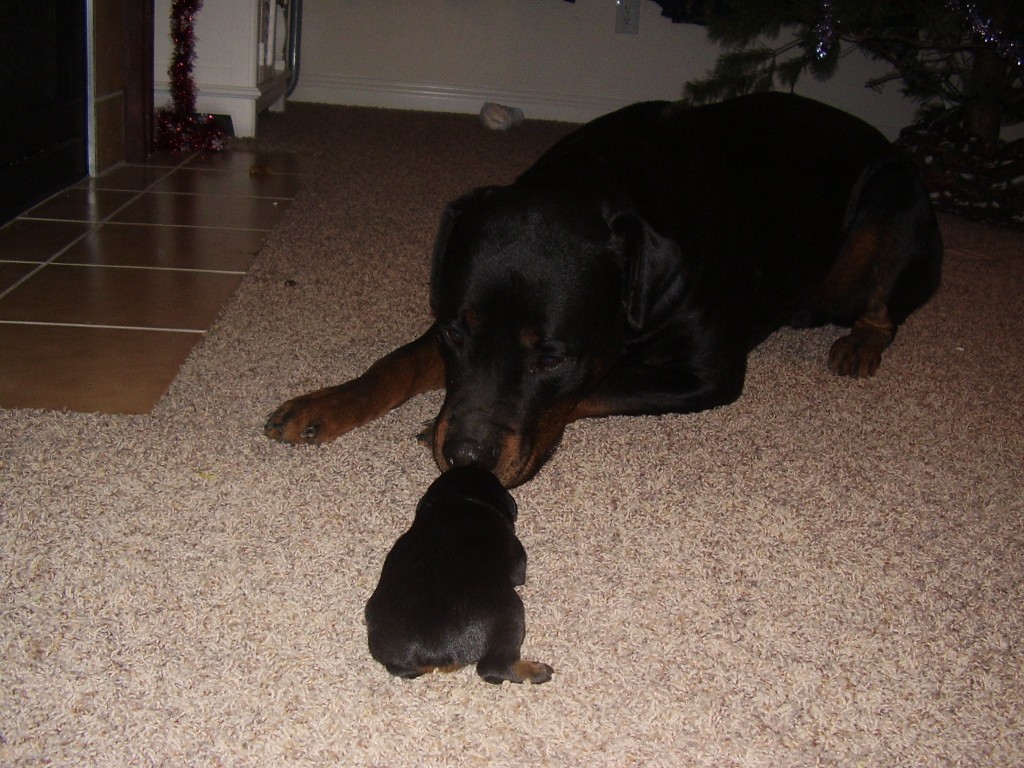 The next HUGE environmental contributor is your dog’s diet. I REALLY cannot emphasize this enough. Most parents understand the value of their children getting a complete diet. If correct nutrition is important for a human child that can take 18-30 years to mature physically and mentally, imagine how much more that nutrition is for your dog who accomplishes that in about 5-10% of that time. Your Rottweiler will do most of his bone growth in the first year- so what it takes us nearly 2 decades to accomplish, he does in 12 months! Hopefully that will further enumerate the importance of correct nutrition. I do NOT recommend vitamin supplements. If your dog is on a good quality, professional dog food, it will provide all the nutrients he/she needs. The only exception to this would be the addition of pre/probiotics or glucosamine and chondroitin, or natural additives such as salmon oil, etc. You most certainly want to avoid excess calcium as research has shown excess calcium, excess protein and excess fat to contribute to FCP, OCD and HOD- all are joint disorders. Correct level of protein in a large breed dog food is 22-27%. There has also been a good amount of research that has shown excess phosphorus in processed dog food can also be a contributing factor.
The next HUGE environmental contributor is your dog’s diet. I REALLY cannot emphasize this enough. Most parents understand the value of their children getting a complete diet. If correct nutrition is important for a human child that can take 18-30 years to mature physically and mentally, imagine how much more that nutrition is for your dog who accomplishes that in about 5-10% of that time. Your Rottweiler will do most of his bone growth in the first year- so what it takes us nearly 2 decades to accomplish, he does in 12 months! Hopefully that will further enumerate the importance of correct nutrition. I do NOT recommend vitamin supplements. If your dog is on a good quality, professional dog food, it will provide all the nutrients he/she needs. The only exception to this would be the addition of pre/probiotics or glucosamine and chondroitin, or natural additives such as salmon oil, etc. You most certainly want to avoid excess calcium as research has shown excess calcium, excess protein and excess fat to contribute to FCP, OCD and HOD- all are joint disorders. Correct level of protein in a large breed dog food is 22-27%. There has also been a good amount of research that has shown excess phosphorus in processed dog food can also be a contributing factor.
R. D. Kealy, S. E. Olsson, K. L. Monti, et al. Effects of limited food consumption on the incidence of hip dysplasia in growing dogs. J Am Vet Med Assoc, 1992;857-63. Forty-eight 8-week-old Labrador Retrievers were allotted to 2 groups of 24 dogs each; 1 group was fed ad libitum and the other group was given 25% less of the same feed until the dogs were 2 years old. Radiography of the hip joints was done when the dogs were 30, 42, 54, 78, and 104 weeks old. Subluxation was measured by the Norberg angle on radiographs made with the dog in the standard (extended limb) position. Independent of age at which the radiography was done, there was less subluxation of the femoral heads in the limit-fed dogs. Using the Swedish method of hip joint evaluation on the same radiographs, it was found that fewer dogs on limited food intake had signs of hip dysplasia. Radiographs done when dogs were 2 years old, for all the methods used (Norberg angle in standard and frog-limb position, the Orthopedic Foundation for Animals [OFA] score, and the Swedish score), revealed less hip dysplasia (less joint subluxation and less degenerative joint disease) in the limit-fed dogs. Using the OFA method, 7 of the 24 limit-fed dogs and 16 of the 24 ad libitum-fed dogs were diagnosed as having hip dysplasia. Similarly, using the Swedish method, 5 of the 24 limit-fed dogs and 18 of the 24 ad libitum-fed dogs were diagnosed as having hip dysplasia. The food-intake-related differences were significant both for the OFA score and for the Swedish score.
The food that you feed is obviously extremely important. It needs to be a food CORRECTLY formulated for large breed dogs. There are MANY large breed dog foods that employ clever marketing but are NOT the correct diet for a large breed dog. So just because the bag says “large breed puppy” on it, it does not mean that it is suited for large breed puppies. It needs to be a diet low in protein and fat to encourage slow, steady growth. It is also important to understand that a “puppy” formula and a “large breed puppy” formula are not the same thing. A “Puppy” formula and a “Large Breed Puppy” formula should be very different from one another if they are correct. Many “puppy” formulas are geared towards smaller breeds and too high in protein and fat and this can be detrimental to your large breed dog. A diet that is too high in protein and fat will not only increase the growth rate but also lead to growth spurts rather than smooth, fluid growth. Sometimes it is better to go with the “Senior” or “Weight Management” formula of a dog food to get the correct balance of proteins and fats.
The owners of giant breed pets tend to overfeed their puppies, having with the best of intention, the inner desire to see a ‘big dog’ and to do nothing which might risk the dog not attaining the greatest possible size. Try as they may, some owners are just unable to restrict their puppy’s diet. Owners are cautioned that their puppy needs a good deal of exercise, but their work schedules often conflict with their desire to do this. The result is a period of intense exercise. A 3 mile run, or a half hour of Frisbee. When a single puppy who lies around all day welcomes his owners in the evening, he is ill prepared for either intense exercise, or the uncertainty of footing on slippery floors and his always changing joint angulation. His muscle tone is a small fraction of that of a puppy which plays with other active dogs all day long. The result is an injury.
Canine Fertility Center – Dr. Mary C. Wakeman, D.V.M.
 Many people who are attracted to the power and physical beauty of the Rottweiler become obsessed with numbers- they want the largest, heaviest dog. When that puppy is born, it’s correct adult weight and size is already predetermined. Keeping the dog heavy and trying to encourage rapid growth may speed up your puppy’s growth but it will NOT change the genetically predetermined adult size. The Rottweiler’s growth rate is already ridiculous in that it will grow 100x it’s birth rate in as little as 12 months- by trying to cut that growing period in half, you are only setting your best friend up for failure. The best thing you can do for your growing large breed dog is to keep him lean. With protein, it is not just the quantity, but the quality as well. Many of the cheaper brands of dog food will fill the food with cheap protein sources like corn gluten, soy, or low-quality meat sources so that they can claim a certain protein level, but because the foods they used are not easily digested by the dog and often pass right though, it is of no benefit to her. If you are going to invest your money on one good thing for your dog, it should be her diet. I hear the argument all the time from people that “but my dog loves that brand” as an excuse for feeding junk. Well, I love Doritos, also made of corn, salt, sugar and a bunch of preservatives, but that does not mean that a daily diet of Doritos would do me any good whatsoever or that there would not be any long term effects on my body. Rottweilers are working breed dogs and we usually ask a lot of them. But how can you possibly expect an athlete to perform on a diet of junk food?
Many people who are attracted to the power and physical beauty of the Rottweiler become obsessed with numbers- they want the largest, heaviest dog. When that puppy is born, it’s correct adult weight and size is already predetermined. Keeping the dog heavy and trying to encourage rapid growth may speed up your puppy’s growth but it will NOT change the genetically predetermined adult size. The Rottweiler’s growth rate is already ridiculous in that it will grow 100x it’s birth rate in as little as 12 months- by trying to cut that growing period in half, you are only setting your best friend up for failure. The best thing you can do for your growing large breed dog is to keep him lean. With protein, it is not just the quantity, but the quality as well. Many of the cheaper brands of dog food will fill the food with cheap protein sources like corn gluten, soy, or low-quality meat sources so that they can claim a certain protein level, but because the foods they used are not easily digested by the dog and often pass right though, it is of no benefit to her. If you are going to invest your money on one good thing for your dog, it should be her diet. I hear the argument all the time from people that “but my dog loves that brand” as an excuse for feeding junk. Well, I love Doritos, also made of corn, salt, sugar and a bunch of preservatives, but that does not mean that a daily diet of Doritos would do me any good whatsoever or that there would not be any long term effects on my body. Rottweilers are working breed dogs and we usually ask a lot of them. But how can you possibly expect an athlete to perform on a diet of junk food?
People often also fail to realize what the correct size of a Rottweiler SHOULD be. Per FCI recognized ADRK German Rottweiler Breed Standards, a male should be around 50 kg/ 110 lbs give or take, and a bitch should be around 40 kg/ 90 lbs. give or take. My Dunjo (picture above) is around 104 lbs and one of the most beautiful, well muscled, conformationally correct athletes I have ever handled. If you think you would improve on his beauty, stamina, or athleticism by adding 40 pounds to him, then quite frankly you do not know how a Rottweiler should look and move. Breeder and owners that become obsessed with owning the heaviest dog or largest dog are not only completely oblivious to the correct German standard, but also do not realize that the health issues related to size increase exponentially as you increase the weight and size. You take a breed of dog that is already prone to joint and cardiac issues and add 40-60 pounds to him and all you will do is exacerbate that problem. Not only do you begin to ruin the look of the Rottweiler (he is no longer a powerfully built hard, muscled athlete, but rather a lumbering, soft, droopy dog like the St. Bernard and Mastiff) but you also lose his athletic ability. He cannot run for miles, leap over walls, or do any of the jobs that the Rottweiler are tasked for. I have long stated that if you simply want a black and brown Mastiff, there are plenty of breeder that produce those, so keep looking, but you will not find that here. I will not shorten the lifespan of my dogs, take away their power and beauty, and increase the health issues simply because someone somewhere decided that Germany, the creator of this breed, has been wrong for nearly a century on what this breed should look like and move like. There is a reason this size was chosen- much smaller and it would not have the ability to be a draft dog, strong enough to stand up to bulls and cows as a herding dog, and powerful enough to do the apprehension work and search and rescue work that it excels in. Much larger, and, as discussed, it simply would not have the stamina to go for more than a block before plopping down. Germany has maintained the integrity of his physical conformation, mental capacity and excellent temperament for nearly a hundred years. Why mess with perfection?
Here are 2 other great articles on hip dysplasia by Carol Beuchat PhD
https://www.instituteofcaninebiology.org/blog/managing-the-risks-of-hip-dysplasia
What is CHD?
Puppies are born with perfect hips, and if the hips do not develop laxity the dog does not develop hip dysplasia (Riser 1985). Joint laxity occurs when the head of the femur does not fit snugly into the acetabulum. This could be the result of traumatic injury, overloading of the joint by weight, lack of muscle strength, or adductor forces (e.g., bringing the legs together). Joint laxity is the primary factor that predisposes a dog to the development of hip dysplasia.
Riser WH. 1985. Hip dysplasia. Ch 83 In Textbook of Small Animal Orthopedics. CD Newton & DM Nunamker, eds.
X-ray of normal hips, courtesy of WIKIPEDIA.
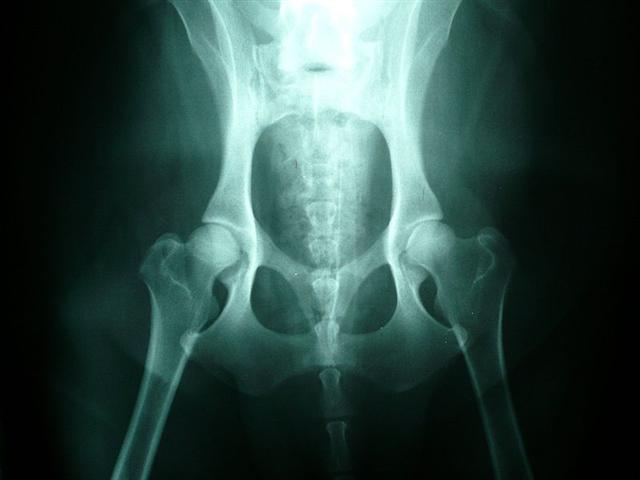 Note that the femur heads are well rounded, the pelvic joint is a strong “C” and the hips fit snugly into position.
Note that the femur heads are well rounded, the pelvic joint is a strong “C” and the hips fit snugly into position.
Canine Hip Dysplasia (CHD), just like Elbow Dysplasia is not a single disease, but rather a group of disorders that are lumped into either hip or elbow dysplasia. If a dog has any of the issues in the group, it is said to have hip dysplasia or elbow dysplasia, respectively.
In order to understand hip dysplasia, it is important to understand the anatomy and physiology of the hip joint. The hip joint allows the legs to connect to the pelvis via a ball and socket joint. The femur (upper thigh bone) head is almost spherical (the ball part of the joint) and fits snugly into the acetabulum, a concave socket located in the pelvis (the socket). The femur head, or caput, as well as the acetabulum are covered by cartilage. The cartilage allows for fluid movement.
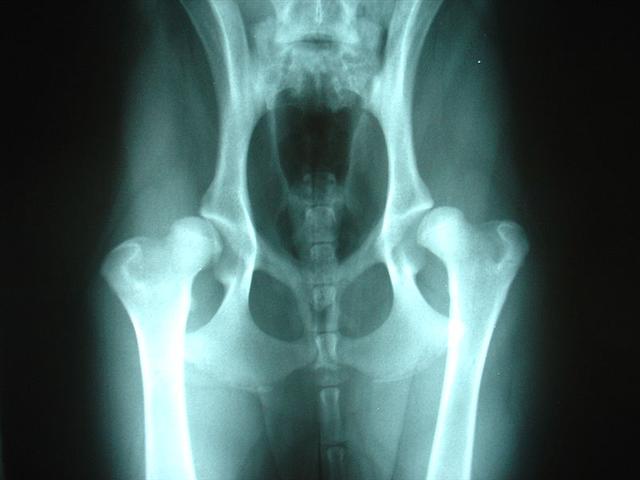
Bilateral (meaning on both sides) hip dysplasia on a cat courtesy of WIKIPEDIA. Note how shallow the hip sockets are and the subluxation (the femur does not fit snugly into the socket- rather looks as though it is ready to completely slip out of the pelvic joint).
Most hip dysplasia is caused by 1 of 3 issues:
• Underdeveloped pelvic muscles– this can happen when the bone growth is too fast and the muscles do not keep up, or can be the result of injury.
• An imperfect femur head– when the caput is not a smooth circular surface, it will interrupt the movement.
• The shape of the acetabulum– the pelvic connection should be a well formed “C” to hold the hip firmly in place. When the acetabulum is more open, like a parentheses “(” it is more difficult for the hip to be held in proper position.
When the hip joint is not formed correctly (due to injury or genetics), it can cause subluxation- meaning cause laxtivity in the joint sometimes to the point of partial dislocation. When the joint does not fit smoothly, it causes excess movement. Make a fist with your right hand. Now cover the fist with your left hand as though you were holding a ball. Now rotate and turn your right hand under your left. Because the left hand (pelvis) covers the right hand (ball of the femur) relatively well, the right hand can turn and move freely but stays where it should. Now take your left hand and open it. Try now to see what the range of motion is with your left fist. You should see that the movement can be very erratic and that the “femur” can largely go where it wants to go. This incorrect movement causes the joint to constantly try to repair itself by forming new cartilage to wither help contain the free moving femur or repair damage that the excess movement has caused. The constant repair causes pain and inflammation and perpetuates a vicious cycle that leaves the hip joint weaker and weaker. CHD can often lead to osteoarthritis which will further degenerate the joint. Osteoarthritis can be seen on an x-ray as excess bony protrusions. This misshapes the joint eve more and the bony outcrops can further damage the cartilage. If hip dysplasia is suspected, the sooner it is caught and the less damage it has done, the more options there are for repairing.
DIAGNOSING CHD
Because of the general “tough” nature of the Rottweiler, diagnosing any medical problems can often be difficult. Sometimes, you need to look for subtle differences in your dog’s behavior and movement. She may take longer to get up or lay down, or she may be unwilling to jump on areas that she previously had no problem with. The dog may also be unwilling to move the rear legs independently of one another and instead have a “bunny hop” gait. CHD can occur at any time during the dogs life, or can occur earlier in life but remain asymptomatic (not show any symptoms) until later in life once the arthritis and osteoarthritis have set in or if another injury aggravates it. Because it can occur during times of rapid growth, it is often confused with with Pano.
Panosteitis, or pano as it is often abbreviated, is not really a disease but rather a growth complication. There are many theories to the exact cause of pano. Some theorize that it can be bacterial in nature, but as pano is unaffected by antibiotics, it rules out the likelihood of it being bacterial. Others theorize that it may be viral, but once again, it does not exhibit the typical viral qualities namely in that it has not been shown to pass from one host to another. Others believe it to be related to vaccinations, and still others credit diet. The medical hypothesis that holds the most weight via research and published literature is that it is related to a conflict in growth plates. When a dog experiences rapid growth, the growth plates can grow at different rates. This conflict in the growth plates causes the pain. As all vet will agree that pano is both more common in large breeds especially breeds that are heavier in bone, and all will also agree that it is growth related, meaning that it occurs after periods of accelerated growth and self eliminates after the growth rate has subsided, the link between the growth plates appears to hold the most weight. Although more specific research is needed in order to provide conclusive evidence as to the exact trigger for pano, the important thing to remember is that because it is both brought on and amplified by fast growth and excess weight, the best preventative and treatment for your dog is to keep him lean. Even if your puppy/youth is only overweight by a few pounds, it can impact the propensity towards pano, especially if the puppy is in a period of rapid growth. Pano occurs most often in a 5-9 month old puppies as this is directly proceeding the time of most rapid growth, but it is an issue that is only associated with the growth of the puppy so it is rare to be experienced in a dog over the age of 12-18 months. If your dog has pano, he may refuse to put any weight on a limb or attempt to restrict movement in that area. One of the attributes that sets pano apart from some of the more serious and permanent joint issues is the nature of pano. Pano usually comes and goes and will often move from limb to limb according the the growth plates that are effected.
TREATMENT OPTIONS for CHD
There are 2 main avenues to take in regards to treatment of CHD- surgical and non-surgical. The least invasive is, of course, non surgical. There are three elements to non-surgical treatment: weight management, exercise and medication. As previously talked about, weight management is the single greatest thing you can do for your growing puppy, and has just as strong of a positive impact if the dog is diagnosed with CHD or any other joint disorder. The less weight on the joints, the less you are making the joint work. Exercise is the next most important element. If the joints are not in great shape, then the dog will need his muscles for support now more than ever. However, I must caution that while mild exercise is extremely beneficial, excess exercise can be detrimental and cause more wear on the joint. One of the best exercised for your dog, especially with CHD or other joint issues is swimming. It allows the dog to build muscle without stressing the joints. The medicine route is one of great controversy. Many believe that anti-inflammatory and pain reducers are helpful, but many of these drugs have very strong adverse side effects, especially for long term use. Rimadyl is one of the most controversial drugs that is prescribed. I do not (knock on wood) have any personal experience with any joint issues directly, but have always preferred a more natural and holistic approach to any given situation whenever possible. Cosequin, Syn-Flex and other joint supplements that are high in glucosamine and chondroitin can help to rebuild cartilage and help prevent further degeneration of the joint. Salmon oil is also great.
X-rays taken of the pelvis immediately after surgery show the rotation of the acetabulum on each side and the plate and screws holding the acetabulum in the desired degree of rotation. Courtesy of ACVS.org

Surgical.
If the non-surgical treatment is not proving effective, or if the the vet believed the dysplasia to be too severe and warrant surgery, there are a couple of different options depending on the age of the dog, progression of the disease(s) and type of hip dysplasia.
Triple pelvic osteotomy or TPS is only effective if there if arthritis has not developed and is best in younger dogs. For TPS, the hip socket is realigned. TPS has been more successful with large breed dogs than excision arthroplasty and FHO.
Excision arthroplasty is a surgery in which the caput is removed and either reshaped or replaced. This surgery often limits the movement of the hip and has better results on smaller breeds of dog.
Another surgery that is used for smaller dogs and cats femoral head ostectomy or FHO is not appropriate for large breed dogs as the size and weight would prove the solution ineffective. In FHO, the femur head is removed as in excision arthroplasty, however, it is not replaced. Instead, the resulting scar tissue from the operation takes the place of the hip joint.
A relatively newer surgery option is a technique developed by Dr. Barclay Slocum and Theresa Devine Slocum called the Dorsal Acetabular Rim arthroplasty or DARthroplasty. “DARthroplasty creates a shelf of bone from corticocancellous strips harvested from the wing of the ilium which are then sutured together to create a cup. This cup is slid under the gluteal muscles and tucked under the rotators, thereby protecting it from the sciatic nerve, then sutured to the joint capsule. The lateral cortex of the acetabular rim is perforated with holes to promote bony fusion of the graft to the rim.
Over a period of several months, a fused boney shelf forms in place of the deficient acetabular rim giving the patient a naturally formed dorsal acetabular rim providing near normal to normal hip function. Most patients can run and do all the usual things young dogs are supposed to do.” (VSRS.net)
Juvenile pubic symphysiodesis, or JPS, is a promising procedure, but it has such a small window (4-5 months of age) that it is not suitable for many cases. JPS, “manipulates the way the pelvis grows to create a tighter hip. It involves cauterizing the growth plates of the pelvis, in other words, the part of the pelvis which would usually grow and spread in puppyhood, no longer does so. To compensate, the rest of the pelvis grows outward, in a manner which enhances the “socket” of the hip and provides better support than that dog would have had naturally.” (Wikipedia) The surgery is only an option during the time when that area of the puppy is at the correct growth rate.
Total hip replacement, THR, is the most drastic, but often the most successful, especially when other surgery treatments are not an option.
Photo courtesy of http://www.2ndchance.info/hipsurgery.htm
 Other complications:
Other complications:
It is important to note that unfortunately, there are often other complications either imposed by CHD or worsened by it. In the show ring, you will hear the phrase “Form follows function” quite a bit, and it is so very true. One of the reasons the movement of the dog is judged is because when the gait is off or not correct, it is almost certain that there is an underlying structural issue to blame. Sometimes, the elbows or knees are diagnosed to be problematic before the hips, and it is often difficult to know which came first, the chicken or the egg. Did the knee or elbow issue cause the dog to compensate in the hips and cause the excess wear on the hips, or did incorrect hip alignment cause stress on the knees or force the dog to compensate by transferring too much weight to the front end and straining the elbow joints? In either case, secondary issues in the other joints are not uncommon. If your dog has excess or unexplained injuries to other joints, it is advisable to have the hips checked just to be safe. Of course joint issues (to include hocks and wrists) can occur without any hip involvement, so it should not be automatically assumed. However, if injury or distress continues to occur especially in combination with an incorrect gait, as stated, checking the hips might not be a bad idea.






